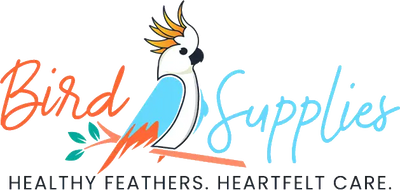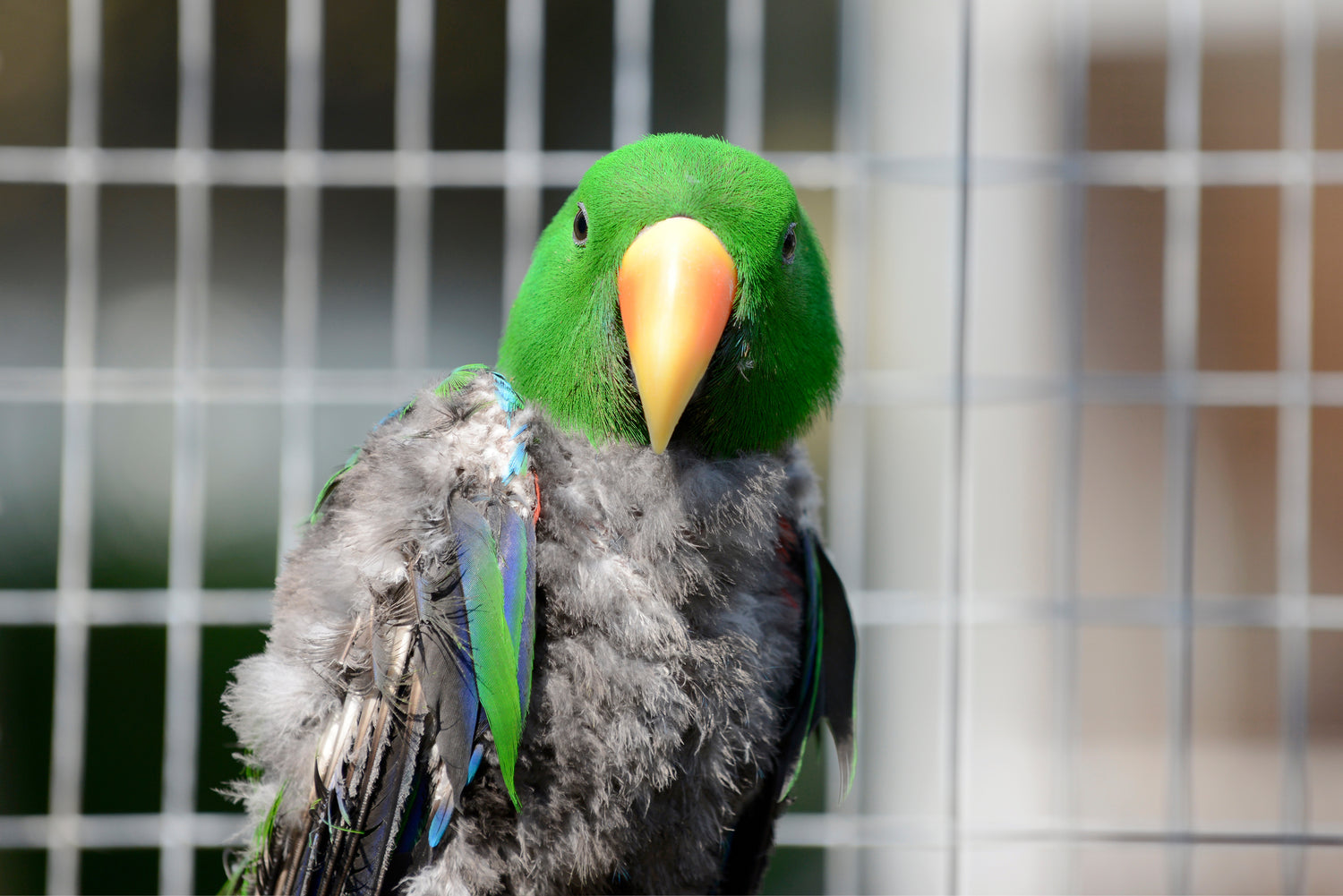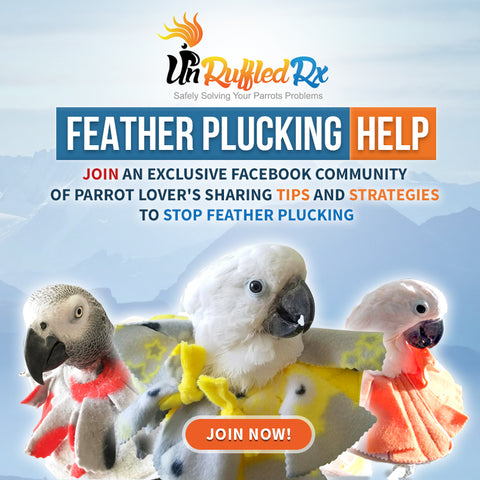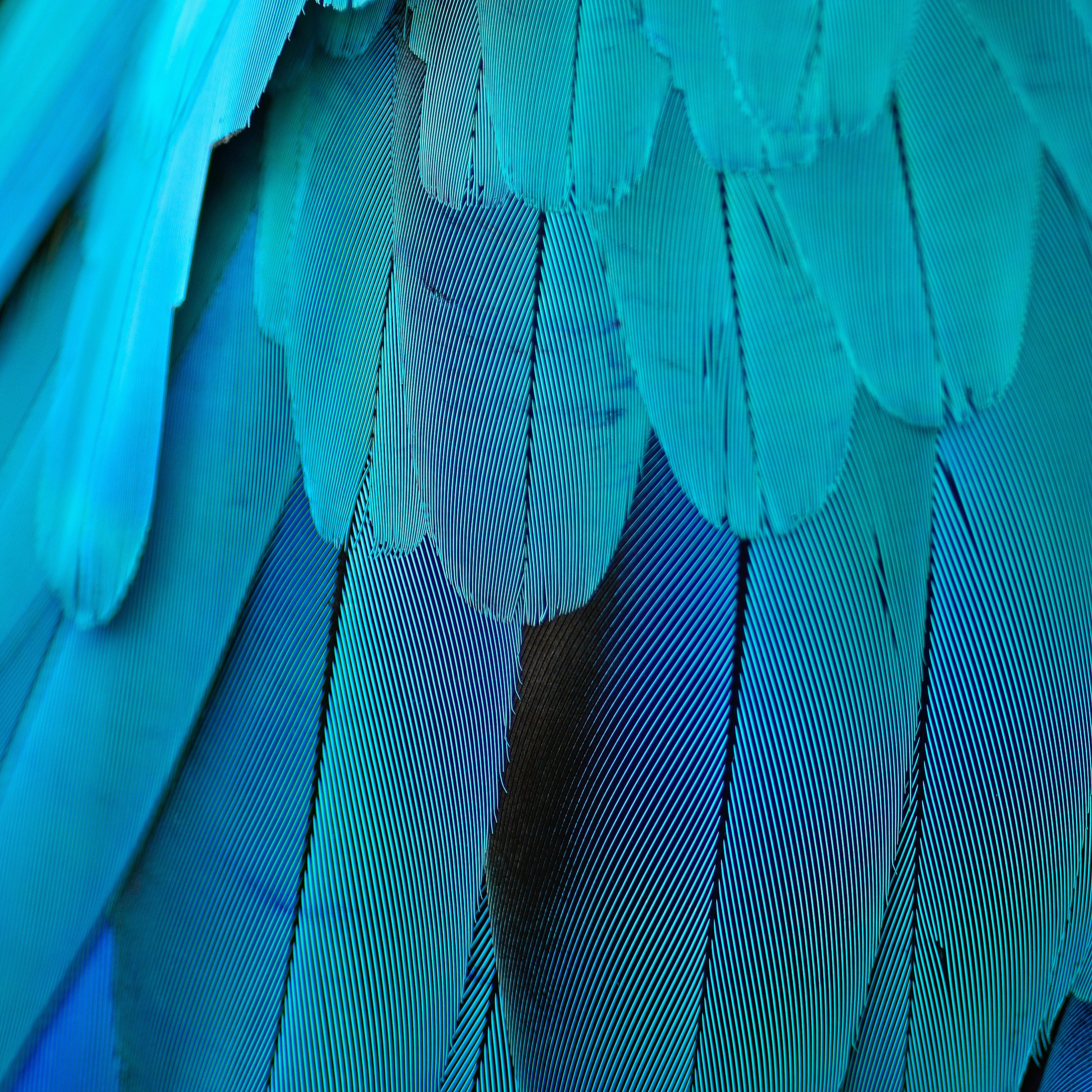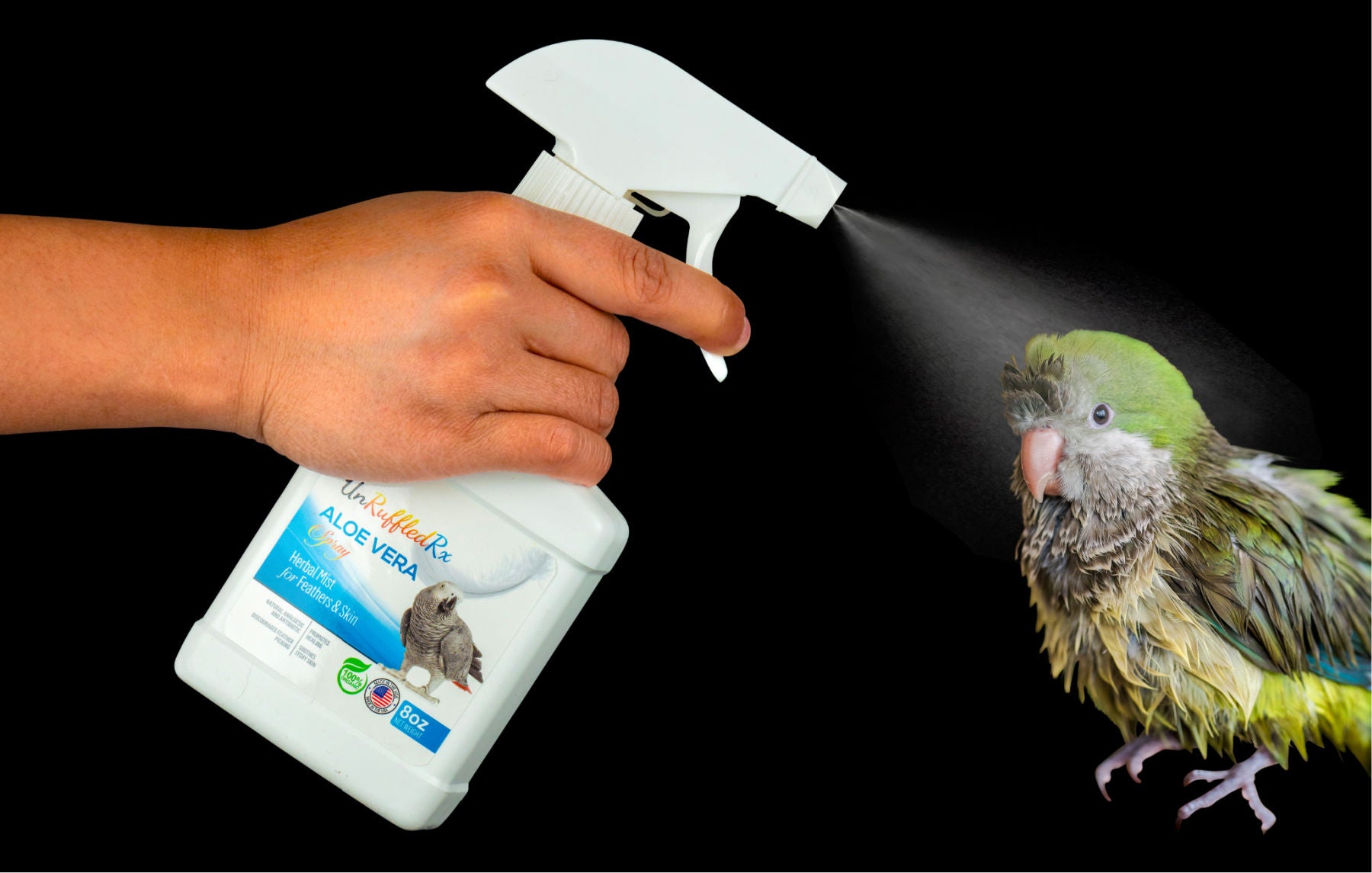One of the most common and challenging problems parrot owners face is feather picking. Not only is it heartbreaking to watch your parrot chew off or pull out its own feathers, but it is also sad to see such a stunningly beautiful creature turn into an unsightly mess.
Moreover, it is scary to see the adverse health effects of feather picking. Birds rely on their feathers for self-esteem, insulation, mating rituals, communication, and skin protection. Ongoing feather picking causes a bird to become chilled and its skin to become dry. The damage can lead to skin infections, suppressed feather follicles, or other serious problems. The purpose of this blog is to offer a simple explanation about the potential causes of feather picking and to offer basic suggestions to help your feather picking parrot.
WHAT IS FEATHER PICKING
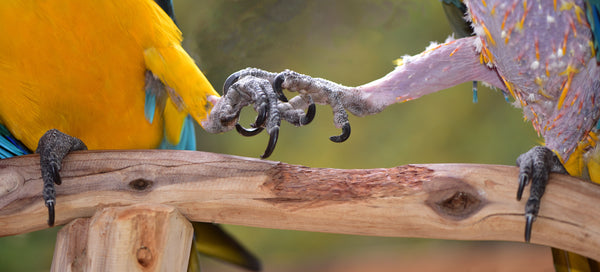
Feather picking is when a bird pulls out its own feathers or chews them off as opposed to safely preening them. We see a variety of intensities of this behavior from mild or periodic feather picking to complete baldness. In the most extreme cases, the bird damages its skin and muscle tissue, This life-threatening disorder is called self-mutilation.

Sadly, the feather picking turns into a hard to break the habit if not managed early on.
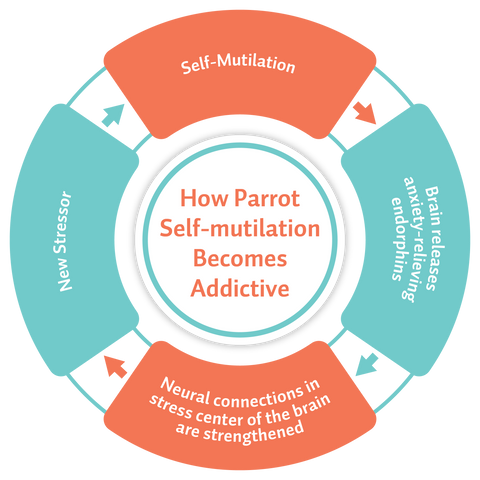
WHAT CAUSES FEATHER PICKING IN BIRDS?
Birds resort to feather picking for a myriad of reasons, but generally, feather picking behavior falls into two categories: medical and behavior. Regardless of the cause, we now know that untreated feather picking often turns into an obsessive-compulsive habit and addiction. The good news is that the earlier it is addressed, the better the prognosis.
There are a number of medical conditions that stimulate feather picking behavior. Basically, anything that causes enough discomfort to drive the bird to seek relief can induce feather picking. Disorders such as malnutrition, infections, endocrine disorders, liver disease, food allergies, exposure to toxins in the environment, parasites, uropygial gland impaction, and other diseases have been known to induce feather picking. A qualified veterinarian will want to perform a thorough physical examination and run a battery of tests to determine if your bird’s feather picking is medical in nature. Of course, medical problems should be treated, but some birds develop a “plucking habit” that needs to be treated with behavioral techniques, in addition to medical treatment.
According to Dr. Tara Sager, DVM two major medical causes of feather picking include hypothyroidism and mineral deficiency.
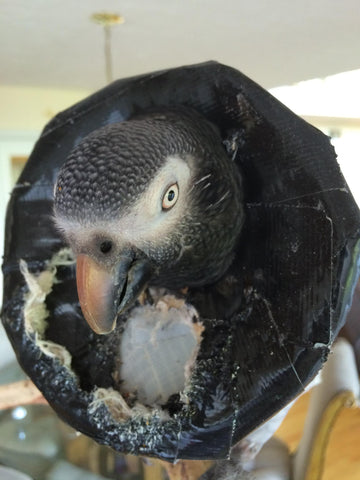
If your avian vet is unable to find a medical cause for the feather picking, then the problem may be determined to be behavioral in nature. There are a number of causes of behavioral feather picking. Behavioral feather picking is often caused by adverse environmental conditions or parrot husbandry conditions. After all, caring for an exotic pet comes with challenges.
Imagine being an exotic pet from subtropical areas of the world who require lots of mental and physical stimulation. Wild birds often live in large flocks and have a social order which allows the flock to thrive. They have daily routine-based lives that help individuals and the entire flock to flourish. Being prey animals, safety is extremely important in their hierarchy of needs.
Imagine how different a flock of hundreds of friends is from the life of a captive parrot. A wild bird is never bored. Your caged parrot needs considerable human contact to minimally simulate the benefits of living in a flock. Caged birds need a plethora of mental stimulation. Their bodies have adapted to the equatorial environment of year-round temperate climate, high humidity levels, consistent photoperiods, and lots of sunlight.
In terms of mental stimulation, these playful, inquisitive creatures need fun, positive companionship daily, a variety of safe mentally challenging activities to stimulate their minds and keep them busy and a predictable routine.
Flock-life brings about a huge sense of safety. There is safety in numbers. Some species of parrots live in flocks numbering in the thousands while others live in significantly smaller communities. We believe that "flock-species" are more prone to feather picking due to the emotional stress of feeling isolated from like species. Thes parrots may be easily stressed by strangers or novel experiences They may be prone to developing higher levels of stress during hormonal periods or simply due to outright boredom. Learn more about hormonal parrots here.
TREATMENT FOR FEATHER PLUCKING
The first rule of thumb to managing feather picking is to get a full physical workup from a qualified avian veterinarian. Your vet will want to do a number of tests to determine if there is a medical cause for the picking. If your vet is unable to find a physical cause, that the feather picking may be attributed to being caused by behavioral concerns.
There are four effective strategies for managing feather picking and self-mutilation in parrots. They include the following:
- Ensuring wellness
- Using a Bird Collar to disrupt the habit
- Parrot Calming Supplements or prescription-grade medications
- Behavior Modification to shape desired behaviors
Keep in mind that you may need to implement 2 or more of these strategies and don’t feel like a failure if you need to implement them all. The key is patience.
ENSURING WELLNESS
While there is no consistent cure for behavioral feather picking, we know that ensuring an optimum environment and physical care is the foundation of modifying feather picking.
1. Diet
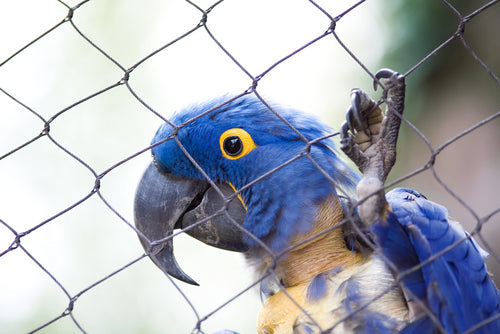
Imagine the huge variety of nutritional plants, seeds, bugs and mineral availability in a rainforest environment. Fruits, nuts, flowers, vegetation, bugs and even mineral-rich clay licks that parrots frequent daily. It’s hard to find such abundant fresh food resources for captive parrots. And even if you could find these foodstuffs, do you feel skilled enough to offer a balanced parrot diet?
Ensuring that your parrot receives proper nutrition is one of the most important factors of parrot health, disposition and feather health. Improper nutrition may be the leading cause of most parrot problems. We strongly urge you to feed your parrot a research-based, nutritionally complete pelleted diet from a leading manufacturer such as Harrison’s or Roudybush. There are a handful of companies that have developed parrot specialty research-based diets that avian vets endorse. Opt for organic diets whenever possible. Avian veterinarians have been recommending that even pelleted diets need to be supplemented with fresh sprouts, vegetables, fruits, and organic grains.
While seed diets had long been considered the staple of a parrots diet, they are very high in fat and simply don’t provide adequate nutrition. Seed manufacturers coat the seeds with vitamins and nutrients, but when the bird cracks open the hull, the vitamins fall to the cage floor. What’s more, parrots are known to pick out their favorite seeds resulting in imbalanced nutritional intake. If your bird is a seed junkie, click here for ideas on how to convert a parrot to pellets. The effort to improve your parrot’s diet is quite worthwhile because feather picking is just the tip of the iceberg when it comes to the medical problems that can result from malnutrition.
Recent research suggests that calcium deficiency has a profound impact on feather picking. Calcium is the most abundant mineral in the body and it not only supports bone and feather growth but it also plays a huge role in mood management, namely anxiety and depression-related behaviors. It is a critical element in the release of neurotransmitters that are responsible for mood management. Of course, calcium should be paired with Vitamin D3 and magnesium. You can offer this by safely placing the cage outside or by using a full spectrum bird light. Some bird-safe calcium-rich foods include leafy greens such as fresh kale, carrots, un-hulled sesame seeds, broccoli, yogurt, and almonds. You may also wish to provide your pet with an avian specific calcium supplement. Overconsumption of calcium and vitamin D3 can have ill effects on overall health and mood, too, so always follow package directions and consult with your avian vet who can determine your bird’s calcium levels and advise you appropriately each year.
2. Sleep
When you think about how much sleep a parrot needs, reflect on the region of the world your parrot is from. Most parrots are from regions close to the equator where there are between 10-12 hours of darkness year-round. Your parrot requires a good 10-12 hours of sleep a night for optimal health. Provide your bird with complete darkness away from the noise so that it can get adequate rest. Even the lights from a television set or LED lights can affect sleep. Bird Snugglies or sleep tents may be helpful. You might want to consider getting a sleep cage your bird to ensure adequate sleep. We’ve found that the Large Wingabago, perched on a Snap and Go Stroller available very cheaply at Once Upon a Child or similar used children’s store, makes an excellent sleep and hospital cage.
3. Bathing
Most wild parrots bathe daily. They are from subtropical locations with high humidity keeping the skin supple. Imagine how wild parrots bathe in natural streams, ponds, and puddles. These water cavities are somewhat muddied with mineral-rich soils that soak into the feathers and provide nutrients when preened.
Surely, you can’t bathe your parrot in dirty puddles. But, daily bathing and misting moisturize the feathers and skin while promoting healthy preening. It also washes away any common household toxins that may have settled on the feathers so that your bird doesn’t ingest them while preening. African Grey parrots, Cockatoo’s and other “dusty” parrots require daily bathing. Dust that settles on the skin can result in dry or itchy skin resulting in a lot of scratching and picking.
The easiest way to bathe a parrot is with a shower perch. A good daily rinse is advised with a thorough soaking at least weekly. Ensure that your bird doesn’t get chilled after the bath. If your bird is plucked it will not have the insulation that feathers provide. Use a blow dryer or a heated panel or perch to offer warmth until your bird dries.
4. Lighting
The availability of UV lighting is critical to your bird’s health. Parrots rely on UV light for proper metabolism and for Vitamin D3 synthesis, a critical component of calcium absorption. Simply placing your bird’s cage near a window is not good enough because modern windows have UV protective film on them. While natural sunlight is best, weather or other animal safety considerations permitting supplemental UV lighting is useful, especially in Northern climates.
5. Safety
Since parrots are prey animals, they have a significant fear response to the unknown. Wild parrots rely on their flock to warn them of impending danger. Not only is there safety in numbers but parrots take turns alerting their flock to danger. Your caged parrot does not have a flock to enhance its sense of security. Therefore, many parrots experience considerable loneliness and anxiety. New experiences or items in the environment may cause your parrot considerable stress. You are the mentor of your “parrot flock.” If you wish to expose your parrot to something new, model that the item is safe and introduce it slowly. And, don’t forget that your parrot needs attention from you, its flock, to feel safe and confident.
6. Boredom
We’ve already discussed how parrots are intelligent yet suffer emotional dysregulation much like a two-year-old child. Your intelligent pet needs constant mental stimulation for its mental health. A bored bird literally feels “caged in” or cabin fever and anxious. You’ll need to provide your exotic pet with significant mental stimulation plus chewing and foraging opportunities throughout the day, whether you are home with the pet or not. Furthermore, your pet needs a predictable routine of family socialization and out of cage time each day.
We strongly urge you to offer your parrot 5-6 assorted toys at all times. While each parrot has its preferred toy styles, consider toys that promote wood chewing, natural fiber preening and foraging or food hiding activities. Switch the toys out frequently. Recycle safe toy parts in foraging buckets with hidden treats to encourage your pet to work for its food.
In the wild, a bird has to navigate to the food site with several flock members. Then it has to figure out how to retrieve the food item. Next, it will fly off to the next food site. Your bird has an innate need to work for its food. Some bird toy manufacturers have recently developed complex, refillable foraging puzzles that make a bird think and work to retrieve small bits of food. Purchase 4-8 food dispensing toys that you can rotate and require your bird work for its food intake. Make your own foraging toys with organic pine cones, bird-safe baskets, and recycled food boxes, food bits wrapped in paper or whatever else you can think of.
A lonely, bored bird that doesn’t know how to entertain itself with toys is trouble and has a high potential of developing parrot behavior problems such as feather picking, screaming, or biting. Your bird needs to know that you are available and that you are coming back. It also needs plenty of toys for mental stimulation and to satisfy chewing, exploring and preening needs. Even if your bird knows how to play, consider making a video or a recording of you talking to and interacting with your bird to play when you are not home. Come up with your own unique strategies to ward off loneliness and share them with us at http://www.birdsupplies.com/contact/
7. Sexual Frustration
It is highly likely that your pet bird will bond deeply with you or another family member and come to perceive you as its mate. Birds that have formed a “pair bond” with one person in the family often regurgitate on the chosen one, while lunging and snapping at perceived intruders in an effort to drive them off. Once a parrot perceives that a family member is its “mate” the bird develops mating related behaviors that are not fun to be around. Hormonal parrots lunge, bite, scream and if unsatisfied, may resort to self-destructive behaviors. Warding off sexual frustration by not having an opportunity to mate and feeling that other family members are creating a “love triangle” causes an incredible amount of stress for a pet bird that comes out behaviorally.
In the wild, most parrot species mate for life. Most parrot species only become hormonal once a year yet the pair has a special bond year-round. When all of the conditions are right, from light to food availability to a proper nest location, parrots will engage in some rituals especially regarding where and how they touch each other and actually breed and raise their young. The rest of the year, the pair is essentially asexual or non-hormonal.
The take away here is that many parrot keepers inadvertently induce a constant state of hormonal behavior in our pets by not permitting them to get adequate sleep, allowing them to create nesting cavities, feeding them protein and fat-rich diets and petting them improperly. Not only is the parrot body not adapted to sustaining a constant hormonal state, but their mental health suffers too. All of that sexual angst comes out in problem behaviors such as biting, screaming and sometimes even feather picking. Prevent inducing a hormonal state by ensuring that your parrot gets adequate sleep, is fed a proper diet and is not allowed to “nest” under furniture or in other darkened, small areas. Furthermore, learn how to pet a parrot to avoid inducing a hormonal state.Cockatoo’s, in particular, are often victims of inappropriate petting because they are such a cuddly bird.
BIRD COLLARS & BIRD VESTS
A bird collar or a bird vest may be required to keep your bird from destroying its feathers or engaging in self-mutilation behavior. There are a variety of bird collars available on the market. Some are made with soft fabrics, others have stiff inserts and others are made from plastic materials or have Kevlar inserts. We strongly suggest that you accustom your bird to wearing apparel following the techniques in this article. Firstly, it is much less stressful for the bird and secondly, a bird that hasn’t been conditioned to wear apparel will chew a collar or barrier up quickly. Even so, expect that your bird will chew on a barrier (as opposed to itself) until it gets used to it.
Some birds may require a bird collar for life while others that haven’t habituated a picking habit can be taught that they'll get attention for safe behaviors like playing, talking, exploring, etc.
FEATHER GROWTH SUPPLEMENTS:
Feather growth supplements used in conjunction with an avian specific multi-vitamin has been reported to be very helpful by a number of our customers. Products like UnRuffledRx FeatherUp!, Nekton Bio and Morning Bird Feather Fast contain important skin soothing, feather growth formulations that support your birds' health as it regrows feathers or undergoes a molt.
If your bird has been picking for a while, constant feather regeneration takes its toll on your bird’s nutritional status. As feather follicles are damaged due to constant irritation, your bird’s skin becomes sensitive. A vicious cycle of obsessively attending to selected areas may have developed. Soothe your birds' skin and affected areas with products like Aloe Vera Spray, Soother Spray, Soother Plus Cream, Rain Spray, or MediHoney. (http://www.birdsupplies.com/topical-creams-sprays/)
CALMING SUPPLEMENTS AND DRUG TREATMENT:
Birds that are prone to anxious and obsessive behaviors are more disposed to becoming feather pickers. Depending on the intensity of the feather picking, you may wish to implement prescription drug treatment to modify the behavior. Two common drugs that avian veterinarians prescribe for pickers and mutilators are Clomipramine and Haloperidol. Naturopathic treatments such as UnRuffledRx Parrot Calming Formula, UnRuffledRx Calming Herbs for Parrots and Chamomile have been reported to be quite effective for mild to moderate pickers.
Keep in mind that using prescription drugs or calming treatments to modify picking does not address the underlying behavioral patterns that your bird has established. We strongly suggest that you also implement proven behavioral modification techniques to train your parrot what behavior will get rewards and attention. Drugs nor barriers and e-collars alone will not completely eliminate a picking habit but will buy you time to establish new feather growth and train your bird while it is in a calmer, more compliant mood.
BEHAVIOR MODIFICATION:
Shaping new behaviors through behavior modification is known to be one of the most effective things that you can do to help your feather picking parrot. This highly researched set of procedures has been used in schools, treatment facilities, zoos, and avian behaviorists for decades. Behavior modification is complicated but you can quickly become proficient at it with our F-R-I-E-N-D approach:
1. FOCUS ON THE FUNCTION OF THE BEHAVIOR
All behavior serves a function. Use a time study to discover the function of your bird's feather picking. Behavior is sandwiched between a trigger and a motivator.
Analyze the “antecedent” that triggers a picking or mutilating response. Be as specific as possible.
Behavior: What specifically was the birds' immediate response. For instance, did the bird immediately go to picking or mutilating or did it engage in a preliminary behavior to “warn” you of its anxiety or angst? In the case of feather picking, there is a sensory component to relieving anxiety.
Consequence: What exactly did the bird get that motivated the behavior. In other words, did the bird get something desired or did is escape something that is undesired?
Take data about the A-B-C behavioral pattern over the course of a week to learn your birds' triggers and what sustains the behavior.

2. REINFORCE CALM, DESIRED BEHAVIORS
Focus on your birds' positive, calm behaviors. This is absolutely critical for a successful outcome of feather picking. Whenever you notice desired behaviors reward your bird:
- Do scratch your bird's head, give it a tasty treat or show it a favorite toy when your bird shows calm and relaxed behavior.
- Don't reprimand undesired behaviors that happen in front of you or when you're away.
3. IGNORE UNDESIRED BEHAVIORS
Ignore undesired behaviors and compulsive behaviors so that you don't inadvertently reward them.
- Look for opportunities to spend relaxed time with your bird, such as enjoying a snack together or teaching a trick.
- Spend time with your bird when he is calm.
- Include daily exercise and playtime into your schedule whenever possible.
4. ELICIT CALM RESPONSES
Let's say that when you turn the TV off, shut the drapes and check the front door your bird becomes anxious, resulting in undesired behaviors such as feather picking, because it thinks that it is bedtime.
- When You're at Home: Act as if you're preparing to bed but don't go anywhere. Turn the RV off. Shut the drapes, but then return to your previous activity several times each day in front of your bird.
- When You Leave: 20-30 minutes before bedtime (preferably at dusk before it turns dark), put your bird back in its cage and give it a favorite distraction, toy or a treat that takes a while to eat. Ignore your bird until its time for bed, then simply walk out without speaking to or giving your bird any attention. As dusk turns to darkness, your bird will naturally fall asleep
- When Morning Comes: Ignore your bird until it is calm and then reinforce this positive behavior with a favorite treat.
5. NURTURE YOUR BIRD'S INDEPENDENCE
Help your bird learn to relax during its triggers.
- Teach your bird to settle by placing it out on a stand and frequently rewarding calm behavior. Label its calm mood as Settle.
- Gradually increase the time between rewarding "settled" behavior.
6. DATA DRIVES DECISIONS
Record your training efforts for the best results. As you get more reflective about how you and your bird are interacting, what your bird motives and needs are, you’ll be able to knowledgeably and naturally implement helpful strategies for feather picking. To download a journal template to monitor your bird's progress visit LINK
Related Posts:
How to manage feather picking
Introducing Your Parrot To Your New Baby
FRIEND Course Questionnaire
References:
Athan, Mattie Sue. Guide to Companion Parrot Behavior, 2nd Edition. Baron’s Educational Series, 2010.
Baxter, Kelly and Lieberman, Mia. Feather Picking in Parrots. UCDavis Veterinary Medicine. No Date.
Connectability.ca ABC Functional Assessment Card
Gallerstein, Gary A. The Complete Bird Owner’s Handbook. Macmillan Genera Reference, 1994.
Heidenreich, Barbara. Good Bird. A Guide to Solving Behavioral Problems in Companion Parrots! Avian Publications, 2004.
Munro Doane, Bonnie and Qualkinbush, Thomas. My Parrot, My Friend. Macmillan General Reference, 1994.
Sager, Tara DVM. Feather Picking and Self-Mutilation in Companion Birds. Parrot Resource Centre, 2012.
